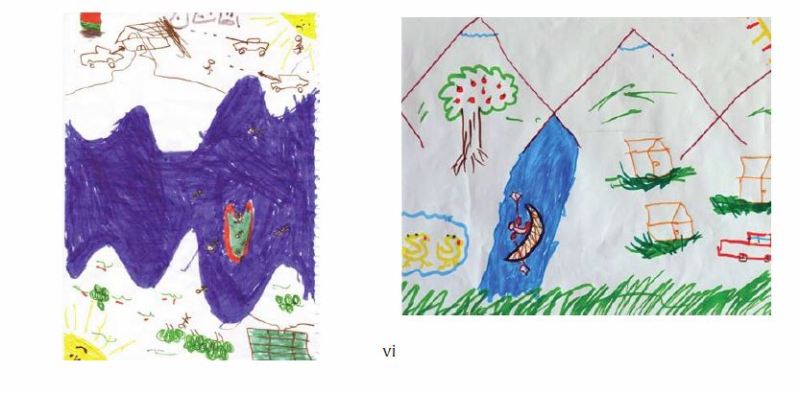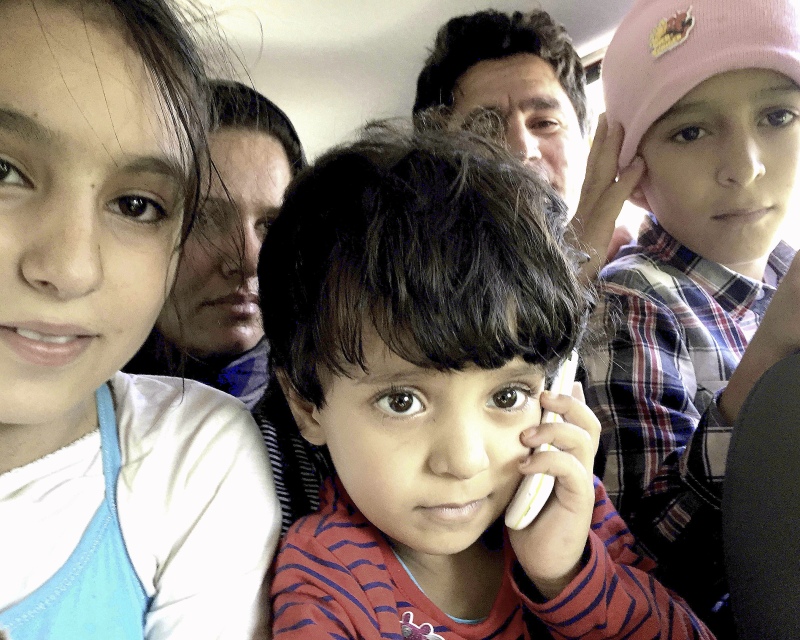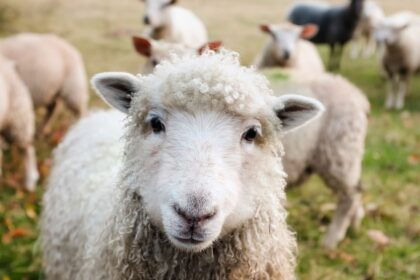By Nicole Melancon of Thirdeyemom, where this story originally appeared
“Our goal is to place a human face on this world event, and meaning to the term refugee. This ongoing crisis is changing the world. We believe there is an urgent need to educate and offer an opportunity for people to connect to the human side of this tragedy.” – Robin and Robert Jones
It was a typical warm April evening on the Greek Island of Lesbos when the first raft arrived that would change this island community— and the world — forever. Santa Barbara-based couple Robin and Robert Jones had been living part-time in the small, beautiful village of Molyvos on Lesbos for the past 42 years. Over time, they’d witnessed the town develop from a fishing and agricultural community to one dependent on tourism.

They were dining with friends at their beautiful home when they looked out the window. Off in the distance — approaching perilously in the sea — was an inflatable raft filled over capacity with people wearing bright orange life vests. There were mothers, fathers, brothers, sisters, babies and grandparents. It would be the first of many rafts to come ashore to their tiny town of 1,000 people.
For these refugees, Lesbos was a beacon of hope from the cruel world of war and death that they were escaping in Syria and other parts of the world. Despite the treacherous passing across the sea, reaching Lesbos represented the promise of a better life.



Lesbos Transitions
In 2015 Lesbos became an epicenter for the refugee crisis sweeping across Europe and Asia. At the beginning, fewer than 150 refugees a week were landing on the island. By the time the Jones’ returned to the US in November, 3,000 desperate people were pouring onto their beaches every day after having made the dangerous crossing from Turkey. They arrived wet, cold, scared and hungry — yet filled with hope.
For the first several months there was no organized help set up. The town — and the world — were completely taken by surprise and unprepared at how to provide aid and services to all the refugees. Thankfully, a large group of volunteers took over and helped by providing food, water and whatever assistance they could. Tragically this was only the beginning of their long mass exodus to safety.
The Jones’ joined other volunteers to help the refugees, over half of whom were women and children. Until buses started in the fall they had to walk 60 kilometers, over mountain roads in sweltering heat, to cross the island to the official Registration centers. Picking up refugees in personal cars was illegal, but many people like the Jones helped transport refugee families.

The Power Of Art
At a rest stop set up for the refugees, Robin, an art teacher, provided paper, colored pens and a blue and white checkered Greek tablecloth spread on the ground to give the children a place to draw. They sketched tanks and guns, but also flowers and homes. Streaks of blue represented the water they had just crossed. The kids were at first a little shy, but then they began to create. And as more and more children got involved, an amazing scene developed. The activity offered a moment of relief to the many children arriving on the beach or entering the temporary chaos of the transit camps.

Robin found a way for the children to step outside the harsh reality of their current situation. Their lives were forever changed by the refugee crisis. Robin and Robert Jones knew while this crisis was unfolding that beyond the words and photos, it was an extraordinary moment for them personally. In that instant, they understood what it was like to care for others who truly needed love.

All of the drawings and photos were done within hours of arrival. The photos and drawings show what the children were seeing and feeling in the moment.

Robin brought table cloths, pads of paper and colored pens to give the children, who had just made the horrendous sea crossing a few hour before, the opportunity to draw pictures and give them a sense of normalcy in the chaotic environment.
There is a power in art — especially made by children — to tell a story that is both heartbreaking, inspiring and healing.

In the coming months, despite the sorrow of the situation, Robin and Robert were able to find optimism through the smiles and resilience of the children.

Sharing A Story Of Optimism With The World
When the Jones arrived back home in Santa Barbara, they realized that they could not turn a blind eye on what they witnessed. They had to act and share their experience with others. They began doing talks around the community to any group that wanted to hear their story. It was at one of the talks that a publisher in the audience told them they should pursue writing a book. They created the book The Refugee Crisis: Through the Eyes of Children so that the shared smiles of the children will never be forgotten and a human face will be placed upon this tragedy.

I had the opportunity to talk with Robin and Robert Jones over the phone to learn more about their life-changing experience. It was a passionate conversation that truly touched my soul. Here is what they had to say.

Interview: Robin and Robert Jones
Q: Tell me more about your personal lives and how you ended up in Greece 42 years ago?
Robin: In the summer of 1974, Robert was traveling around Greece and I was there visiting my sister when we met on the island of Hydra. From there we traveled by ferry to the island of Lesbos and the beautiful village of Molyvos, where we fell in love with each other and the village. We married in Toronto and in 1975 had our first child and named him Michael “Molyvos” Jones. At ten days old, we took him to Molyvos and spent 18 months there. We had two more sons and frequently returned to the island with our children. Eventually we bought a second home there and we have gone back and forth for over 42 years now. Molyvos is a part of our hearts.
Q: When the refugee crisis began, how did you react? What inspired you to help?
Robert: When we came to Lesbos in April 2015 it started as a trickle and slowly increased to about 100 arrivals a day. By August, the real crisis had begun as we were receiving about 1,000 refugees a day. It was a completely overwhelming and devastating situation. The people were arriving on the beach soaking wet, disoriented and hungry. They couldn’t speak English or Greek so we couldn’t communicate with them.
For our tiny village, it was very difficult as there was no organized help at all. None of us knew what to do as we weren’t trained on how to handle the situation. We didn’t have food, clothing, water or anywhere for the refugees to go. There were no buses to transport them so they had to walk for up to two days over mountainous terrain. It was a very heartbreaking situation. They were desperate and we all wanted to help. Local restaurants put together sandwiches, and Robin and I brought food and water as often as we could. We even transported some of the most desperate families in our car even though it was illegal.
Finally, a transit stop was created by a local woman named Melinda McCrostie who started the amazing STARFISH FOUNDATION in the parking lot of an old disco. It was here that Robin came up with the idea of using her experience as an art teacher to help the children.
Throughout the crisis, we always felt a strong urge to help. We would see people and immediately feel a rush of adrenalin and a call to act. In my opinion, human beings have a choice to help or do nothing. There was no way we could turn a blind eye.
Robin: It was the bright smiles of the children that inspired me to help. We were fortunate to be in an opportunity to help. To feel what it is like to see people in need and they are still smiling. They had just been through such a traumatic experience yet their resilience astounded me and gave me courage. Art has been my life long love and I knew that it could be used as a vehicle to help the children.
Q: What impact did the refugee crisis have on the island?
Robert: When refugees came, it deeply affected the village. The economy was based on tourism; however, once the crisis began tourists stopped coming. People in the community were very angry and divided. There was a strong belief by many of the locals that if you help a refugee, they will get on a cell phone and tell their friends to come to Greece as these people are helping you. It divided the village. Tourism is still dead and many villagers have lost their livelihoods. Economically, it has been devastating and unfortunately it has become political leading to an increase in xenophobia and a raise in anti-immigration sentiments.
Q: How did it change you?
Robin: The experience brought us closer together on an emotional level. It was so traumatic and difficult witnessing such sadness. Often we were shaking trying to understand what we were seeing and how we could help. It was very hard. Robert wrote and I took photographs because we wanted to record what we observed and felt. It was our way of coping with the experience.
It also empowered us. The timing of this story has become more relevant. It has added another layer to their lives as advocates sharing their story and educating others.
Robert: What was incredibly difficult is the fact that no one could get away from the tragedy of the crisis. Bodies would wash up on shore. Families would lose their loved ones. They would arrive so scared and disoriented. Some villagers were unable to help for personal reasons; but Robin and I had to help.
There were some days when I woke up and realized I could not do this today. Those were the needed days to help clean up what was left behind. I would find whistles, and tossed out birth certificates and passports. Then at night, I would go home and record what I saw in my journal. It was my way of coping with the crisis. While Robin would take photographs and work with the children.
Q: What was one of your most profound memories of the experience?
Robert: I will never forget the time Robin and I picked up a family in our car. They looked like they couldn’t make the two-day walk so we gave them a ride. We were passing hundreds of refugees on the road. I kept looking back at the family and their faces so full of hope. Yet I knew where we were taking them: to the refugee registration center and from there on, who knows where they would end up. All the borders in Europe had just been closed.
I couldn’t get the car to go any slower as I felt so profoundly sad. I will never forget them.

Robin: For me it was seeing the incredible resilience of the children. They were smiling and happy. It inspired me and pushed me to help more. Children are the hope of our future. This is why we dedicated our book to the children.
I met Sahar Kharsa, a beautiful woman who was six months pregnant from Syria. She agreed to be recorded as she told her story — sadly one I’d heard too many times. She described how happy she and her husband were, and how scared she became every time her husband left for work, or his cell phone was out of range. They knew he was in danger. They had to leave to find safety and a better life for their son soon to be born
Q: Tell me more about the refugee children and families. There is a big misperception in America about refugees especially from Syria.
Robert: The book and our presentations are simply to put a human face on these people. The news media continually pushes fear. People are not seeing human beings and are just hearing the word refugee. Many of these people are just like us. They want the best for their children and a future. The more we can see families being reunited and see them as fellow human beings, the more we can understand them. We can assimilate them. It is important to remember that our country is based on immigrants.
Q: What inspired you to write the book? What are you hoping to achieve?
Robert: It was our way of healing from the experience. We couldn’t turn away from what had happened. I remember a Greek friend telling me that I could leave and walk away from the situation at any time; but for me, I will never forget the experience. The book was written as a journal of my thoughts. Together with Robin’s gorgeous photography, it is a way to shed light on the refugee crisis.
Robin: We wrote the book to put a human face to refugee conflict. The travel ban has put this right up to the center again. These are the people certain politicians are trying to keep out. The message is to not let fear confuse and close people’s hearts, but hopefully be able to see the refugees as human beings.
Q: What can people do to help out?
Robin: Educate yourself and be more compassionate. Open your heart and do not rush to judgment that not all refugees are what sound bites presents them as. Plus you can also donate to organizations that help refugees, sponsor new arrivals or call your government official and ask them to support refugee programs. Even just talking with your friends about refugees helps. There are still 5,000 refugees stuck in camps on Lesbos with nowhere to go. Many people still need help.
To learn more about Robin and Robert’s experience, you can purchase their book The Refugee Crisis: Through the Eyes of Children.
Jessica Festa
Latest posts by Jessica Festa (see all)
- A Culturally-Immersive Adventure In Mongolia’s Altai Mountains - Jul 8, 2023
- This Recipe Sharing Platform Supports Women In The Culinary Industry (Labneh Recipe Included!) - Nov 5, 2020
- Hiking The Mohare Danda Community Eco-Trek In Nepal - Jun 3, 2020
- 6 Important Questions For Choosing A Responsible Yoga Retreat - May 18, 2020
- How To Create & Grow A Profitable Blogging Business (Ethically) - Jan 18, 2020






